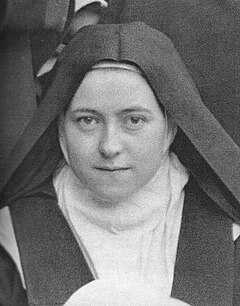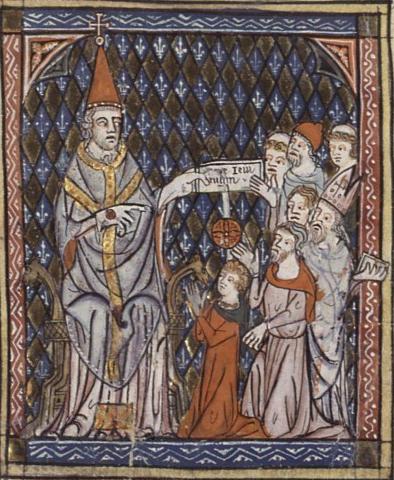Text and Illustrations from Wikipedia - the free encyclopaedia,
unless otherwise stated.
Saint Margaret Mary Alacoque.
Virgin.
Feast Day 17 October.
Double.
White Vestments.
English: Saint Margaret Mary Alacoque.
Catholic Parish Church of Saint Gordian and Saint Epimachus,
Merazhofen, Germany. Sculptor: Peter Paul Metz, 1896.
Deutsch: Margaretha Maria Alacoque. Kath. Pfarrkirche St. Gordian und Epimachus, Merazhofen, Stadt Leutkirch im Allgäu, Landkreis Ravensburg. Chorgestühl, 1896, Bildhauer: Peter Paul Metz.
Catholic Parish Church of Saint Gordian and Saint Epimachus,
Merazhofen, Germany. Sculptor: Peter Paul Metz, 1896.
Deutsch: Margaretha Maria Alacoque. Kath. Pfarrkirche St. Gordian und Epimachus, Merazhofen, Stadt Leutkirch im Allgäu, Landkreis Ravensburg. Chorgestühl, 1896, Bildhauer: Peter Paul Metz.
Polski: Małgorzata Maria Alacoque. Rzeźba z kościoła parafialnego pw. św. Gordona i Epimachusa w Merazhofen (Niemcy). Autor dzieła: Peter Paul Metz, 1896.
Photo: May 2009.
Source: Own work.
Author: Andreas Praefcke.
(Wikimedia Commons)
Saint Margaret Mary Alacoque, V.H.M. (French: Marguerite-Marie Alacoque) (1647-1690), was a French Roman Catholic Nun and Mystic, who promoted Devotion to The Sacred Heart of Jesus in its modern form. [Editor: The Order of The Visitation of Holy Mary (V.H.M.), or The Visitation Order, is a Roman Catholic Religious Order for Women. Members of The Order are also known as The Salesian Sisters, or, more commonly, as The Visitandines.]
Saint Margaret Mary Alacoque was born in 1647, in L'Hautecour, France, now part of the Commune of Verosvres, then in the Duchy of Burgundy, the only daughter of Claude Alacoque and Philiberte Lamyn, who had also several sons. From early childhood, Margaret was described as showing intense love for The Blessed Sacrament, and as preferring silence and Prayer to childhood play.
After her First Communion, at the age of nine, she practised, in secret, severe corporal mortification, until rheumatic fever confined her to bed for four years. At the end of this period, having made a Vow to The Blessed Virgin to Consecrate herself to Religious Life, she was instantly restored to perfect health. In recognition of this favour, she added the name "Mary" to her Baptismal name of "Margaret". According to her later account of her life, she had visions of Jesus Christ, which she thought were a normal part of human experience, and continued to practice austerity.
English: Apses of the Basilica of Paray-le-Monial, France.
Français: Paray-le-Monial, les apsides.
Photo: 17 August 2007.
Source: Own work.
Author: Jan Sokol.
(Wikimedia Commons)
Saint Margaret Mary Alacoque lost her father at a young age, and the family's assets were held by a relative, who refused to hand them over, plunging her family into poverty. During this time, her only consolation was frequent visits to Pray before The Blessed Sacrament in the local Church. When she was seventeen, however, the family regained their fortune and her mother encouraged her to go out into society, in the hopes of her finding a suitable husband. Out of obedience, and believing that her childhood Vow was no longer binding, she began to accompany her brothers in the social events of her society, attending Dances and Balls.One night, however, she returned home, dressed in her finery, from a Ball for a Carnival, when she experienced a vision of Christ, scourged and bloody, in which He reproached her for her forgetfulness of Him, and of how His Heart was filled with love for her, due to her promise. As a result, she determined to fulfill her Vow, and entered, when almost twenty-four years of age, The Visitation Convent at Paray-le-Monial, on 25 May 1671, intending to become a Nun.
Saint Margaret Mary Alacoque was subjected to many trials to prove the genuineness of her vocation. She was "Admitted to Wearing The Religious Habit" on 25 August 1671, but was not allowed to make her "Religious Profession" on the same date of the following year, which would have been normal. Finally, she was admitted to "Profession" on 6 November 1672.

English: Painting of Jesus appearing to Saint Margaret Mary Alacoque.
The Church of San Michele, Cortemilia, Italy.
Italiano: Cortemilia. Chiesa Parrocchiale di San Michele. Rodolfo Morgari:
Santa Margherita Maria Alacoque e la devozione al Sacro Cuore.
Photo: 6 June 2008.
Source: Own work.
Author: User:Giovanni Destefanis.
(Wikimedia Commons)
On 27 December 1673, The Feast of Saint John (Apostle and Evangelist), Saint Margaret Mary reported that Jesus permitted her to rest her head upon His Heart, and then disclosed to her The Wonders of His Love, telling her that He desired to make them known to all mankind and to diffuse The Treasures of His Goodness, and that He had chosen her for this work.
Initially, discouraged in her efforts to follow the instruction she had received in her visions, Saint Margaret Mary Alacoque was eventually able to convince her Superior, Mother de Saumaise, of the authenticity of her visions. She was unable, however, to convince a group of Theologians of the validity of her apparitions, nor was she any more successful with many of the Members of her own Community, and suffered greatly at their hands.
English: Painting of Blessed Mary of The Divine Heart, and
Saint Margaret Mary Alacoque, in Adoration of The Sacred Heart of Jesus.
Deutsch: Andachtsbild: Jesus offenbart sein Herz (Herz Jesu) der sel.
Maria Droste zu Vischering und der hl. Margaretha Maria Alacoque.
Photo: 4 March 2008.
Source: Own work.
Author: Bremond.
(Wikimedia Commons)
After Saint Margaret Mary Alacoque's death, the Devotion to The Sacred Heart was fostered by The Jesuits and was the subject of controversies within The Church. The practice was not officially recognised until seventy-five years later.
The discussion of Saint Margaret Mary Alacoque's own mission and qualities continued for years. All her actions, her revelations, her spiritual maxims, her teachings regarding the Devotion to The Sacred Heart, of which she was the chief exponent, as well as the Apostle, were subjected to the most severe and minute examination, and, finally, The Sacred Congregation of Rites passed a favourable vote on the Heroic Virtues of this "Servant of God".
English: Saint Margaret Mary Alacoque contemplating The Sacred Heart of Jesus.
Italiano: Santa Margherita Maria Alacoque contempla il Sacro Cuore di Gesù.
Polski: Św. Małgorzata Maria Alacoque adoruje Najświętsze Serce Jezusa.
Date: 1765.
Source: Lib-Art.com.
Author: Giaquito Corrado.
(Wikimedia Commons)
In March 1824, Pope Leo XII pronounced her Venerable and, on 18 September 1864, Blessed Pope Pius IX declared her Blessed. When her tomb was Canonically opened in July 1830, two instantaneous cures were recorded to have taken place. Her incorrupt body rests above the Side Altar in The Chapel of The Apparitions, located at The Visitation Monastery in Paray-le-Monial, and many striking Blessings have been claimed by Pilgrims attracted there from all parts of the World.Saint Margaret Mary Alacoque was Canonised by Pope Benedict XV in 1920, and, in 1929, her Liturgical Commemoration was included in The General Roman Calendar for Celebration on the day of her death, 17 October.
In his 1928 Encyclical, Miserentissimus Redemptor, Pope Pius XI affirmed The Church's position, regarding the credibility of her visions of Jesus Christ, by speaking of Jesus as having "manifested Himself" to Saint Margaret Mary and having "promised her that all those who rendered this honour to His Heart would be endowed with an abundance of Heavenly Graces".
The Vision of The Sacred Heart of Jesus
to Saint Margaret Mary Alacoque.
Artist: Antonio Ciseri (1821–1891).
Date: 1888.
Current location: Florenz, Chiesa del Sacro Cuore, Italy.
Source/Photographer: http://www.kunst-fuer-alle.de/deutsch/kunst/kuenstler/
kunstdruck/antonio-ciseri/8632/2/132040/die-vision-des-herzens-jesu-der-
seligen-marguerite-marie-alacoque/index.htm.
kunstdruck/antonio-ciseri/8632/2/132040/die-vision-des-herzens-jesu-der-
seligen-marguerite-marie-alacoque/index.htm.
(Wikimedia Commons)
Saint Margaret Mary Alacoque's short Devotional Writing, La Devotion au Sacré-Coeur de Jesus (Devotion to The Sacred Heart of Jesus), was published posthumously by J. Croiset in 1698, and has been popular among Catholics."And He [Christ] showed me that it was His great desire of being loved by men, and of withdrawing them from the path of ruin, that made Him form the design of manifesting His Heart to men, with all the treasures of Love, of Mercy, of Grace, of Sanctification and Salvation, which it contains, in order that those who desire to render Him and procure Him all the honour and love possible, might themselves be abundantly enriched with those Divine Treasures, of which His Heart is the source." — from "Revelations of Our Lord to Saint Margaret Mary Alacoque".
In James Joyce's Short Story, "Eveline", part of his "Dubliners", a "coloured print of the promises made to Saint Margaret Mary Alacoque" is mentioned, as part of the decorations of an Irish home at the turn of the 20th-Century, testifying to Saint Margaret Mary's enduring popularity among Irish Catholics.

English: Stained-Glass Window in the Church of Our Lady of Vertus, Aubervilliers, France, depicting Saint Margaret Mary Alacoque seeing Our Lord's Sacred Heart.
Deutsch: Bleiglasfenster in der katholischen Pfarrkirche Notre-Dame-des-Vertus
in Aubervilliers, Darstellung: hl. Margareta Maria Alacoque.
Photo: 31 March 2011.
Source: Own work.
Author: GFreihalter.
(Wikimedia Commons)
Margaret Mary Alacoque was born at Vérosvres, in the Diocese of Autun, France, in 1647. While still young, she Consecrated herself to Jesus Christ by a Vow of perpetual Virginity. At the age of twenty-three, she entered the Convent of The Visitation Order at Paray-le-Monial.
The Mysteries of The Sacred Heart were revealed to her in three special manifestations, all unknown to her Community. Saint Margaret Mary spent the last years of her life in spreading this Devotion. She died on 17 October 1690, at the age of forty-three years. Her body was buried under a slab, close to the grille in the Nuns' Chapel, on the spot where she was kneeling when Our Lord appeared to her.
She was Beatified by Pope Pius IX, in 1864, and Canonised by Pope Benedict XV on The Feast of The Ascension 1920. Pope Pius XI extended her Feast to the whole Church on 28 June 1929.
In order to live in the spirit of The Liturgy (which is also the spirit of The Church), and Consecrate The First Friday Of The Month to The Sacred Heart (as The Church does by granting Indulgences), let us adapt this Devotion to the different Feasts of The Cycle. It will thus give a greater variety, both in its material object (The Sacred Heart of Jesus born at Christmas, dying on Good Friday, rising again at Easter), and in its formal object, the love of Jesus in His Joyful, Sorrowful, and Glorious Mysteries.
Mass: Sub umbra illíus.

THE SAINT ANDREW DAILY MISSAL
THE SAINT ANDREW DAILY MISSAL
Available (in U.K.) from
Available (in U.S.A.) from


.jpg)





















.jpg)
%252B(2).jpg&container=blogger&gadget=a&rewriteMime=image%2F*)